What better occasion than Father's Day to consider the patriarchy? Our list of new titles for dads kicks off with a cultural history that does just that.
We've also got an exciting Swiss novel about a dude haunted by the ghost of his father, a portrait of Southern California punk for the ever-expanding dad rock category (it's not just, like, Steely Dan or Wilco), an oral history of aging trans people whose life stories often touch on dads (some are allies or even role models, while others are, well, complicated). Other nonfiction entries offer stimulating views into the natural world, a nostalgia-steeped survey of teen movies, and more.

Augustine Sedgwick. Scribner, $30 (352p) ISBN 978-1-6680-4629-6
Fathers’ role in upholding the social order and their struggles with unruly sons are probed in this winsome and erudite study of patriarchy. CUNY historian Sedgwick (
Coffeeland) offers biographical sketches of famous dads and their children, from an ancient Sumerian named Shuruppag, who wrote a querulous, plaintive advice-tablet to his son—“The instructions of an old man are precious: you should comply with them!”—to Bob Dylan, who stoked rebellion in young people yet himself became, Sedgwick notes, a doting, apolitical paterfamilias rather like his own middle-class father. Along the way Sedgwick explores Aristotle’s belief that the state rested on a foundation of fathers ruling over households, Thoreau’s longing to escape from his father’s Massachusetts pencil factory, and Charles Darwin’s rapt study of his 10 children for insights on how they inherited traits from him. Sedgwick teases out the contradictions between patriarchy as a doctrine of benevolent control and its reality as a form of constraint and domination that often breeds resistance. He plays on these ironies in elegant, evocative prose, as in his analysis of Sigmund Freud’s Oedipal complex (“From a child’s perspective, Sigmund Freud’s theories made it natural, even healthy, to despise your father. From a father’s perspective, Freud made it normal, even good, to be hated”). It’s a fresh and insightful meditation on the paternal dilemma.
(May) 
Markus Werner, trans. from the German by Michael Hofmann. New York Review Books, $15.95 trade paper (144p) ISBN 978-1-68137-912-8
This effervescent 1985 novel from Swiss author Werner (
On the Edge), who died in 2016, follows a ruined middle-aged man haunted by the ghost of his father. Franz, a divorced former clergyman who was defrocked after cheating on his wife, receives frequent visits from his late father, Klement, who appears as a frog in his throat. That’s about it for the plot; what drives the narrative are the men’s irresistible voices, as Franz rues his past decisions (“I sit around, I drink, I brood, I pat myself down for flaws and find many”) and Klement, a socialist dairy farmer, presses his religious and philosophical convictions onto his son (“You stern Franz, now you have no choice, the only possible way forward for you is to sin, and therefore it is no sin”). As each character attempts to justify his existence, Werner fashions their competing viewpoints into a wry treatise on modern masculinity. Brilliantly translated by Hofmann, who provides an illuminating introduction, this sly and strange father-son dialogue deserves to be a cult classic.
(Mar.) 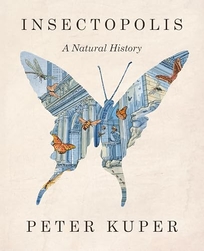
Peter Kuper. Norton, $35 (256p) ISBN 978-1-324-03571-8
Eisner winner Kuper (
Ruins) delivers a lyrical graphic history of the relationship between insects and humans. From griffonflies the size of hawks that “ruled the skies” during the Carboniferous era to how malaria impacted conquerors worldwide (Hannibal lost an eye to it), insects—all 10 quintillion of them—have constantly fluttered and crawled their way through history. The narrative opens with a brother and sister heading to an exhibit on insects at the New York Public Library. Then a disaster wipes out humanity, and insects reign. “Much, much later,” talking monarch butterflies, dung beetles, and other insects explore the building (“Wow! An entire library filled with exhibits about us!”). From bees to ant farms, how humans tolerate and even sometimes deify (“I was sacred, damnit” the dung beetle shouts) the ubiquitous life-forms is rendered in acrobatic storytelling. In addition to profiles of scientists like Rachel Carson, other human notables, including novelist Vladimir Nabokov—a dedicated butterfly enthusiast—get their due. A visual tour de force, the page layouts juxtapose myriad insects against the majestic architecture of the library, and the highly detailed drawings of the exhibits contain countless Easter eggs, including QR codes that lead to supplemental audio. Kuper’s visuals are breathtaking and many moments, like a monarch suddenly perceiving the magnetic field that will guide her home, are magical. It’s a stunning achievement.
Agent: Judith Hansen, Hansen Literary. (May)

Robert Macfarlane. Norton, $31.99 (384p) ISBN 978-0-393-24213-3
Nature writer Macfarlane (
Underland) serves up a lyrical inquiry into the implications of treating rivers as living beings worthy of reverence and legal rights. Recounting his travels along the Río Los Cedros in Ecuador, Macfarlane profiles the dogged conservationists defending the river from logging and mining interests, and discusses how their activism secured the inclusion of legal protections for the natural world in the country’s most recent constitution, ratified in 2008. He weaves together his recollections of kayaking Canada’s Magpie River with an account of how Indigenous resistance to hydroelectric development successfully prevented the river’s damming and led a municipal government to recognize it as “a living, rights-bearing being” in 2021. The fate of Ennore Creek—an offshoot of the Kosasthalaiyar River in Chennai, India—serves as a cautionary tale of what happens when rivers aren’t protected, Macfarlane suggests, describing how British colonial zoning practices concentrated polluting industries on the city’s outskirts where the water still flows “grey-green and sluggish... slick with effluents, sewage and other pollutants.” Macfarlane skillfully braids his immersive travel writing with illuminating historical background, all told in lithe prose (“The horizon widens into ocean and the co-motion of sky and water is lost in a white, grainy light, and there the [Magpie] river’s last trace is slow-vanishing spirals in the water, shallowing as they slip on”). Nature lovers will be riveted.
(May) 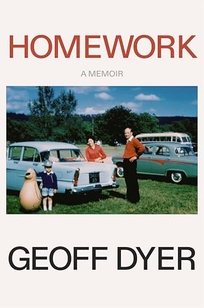
Geoff Dyer. Farrar, Straus and Giroux, $29 (288p) ISBN 978-0-374-61622-9
In this raucous coming-of-age memoir, novelist and journalist Dyer (The Last Days of Roger Federer) recalls growing up in the 1960s and ’70s in the English town of Cheltenham. Dyer’s industrious parents shared in Britain’s new working-class prosperity by buying the previously unimaginable luxuries of a house and car. Meanwhile, Dyer’s academic chops catapulted him into a toney grammar school, then to Oxford. Much of the book is a deep dive into the period’s boy culture and its obsessions with trading bubblegum cards and building models of WWII warplanes. Along the way, Dyer’s rich portraits of his parents reveal how they were at odds with the new Britain: his mother’s disfiguring birthmarks made her feel inferior to her newly glamorous surroundings, and his father was a tightwad, suspicious of consumerism but endlessly trustful of government authority. Dyer’s reminiscences brim with irony and black humor about an era that trumpeted progress, but was suffused with postimperial decline—in the family garden, Dyer’s father “aimed to grow all the carrots, peas, potatoes and other vegetables that we would need to live on in the event of a catastrophic collapse.” The result is an arresting and evocatively detailed take on family and society. Photos.
Agent: Sarah Chalfant, Wylie Agency. (June) 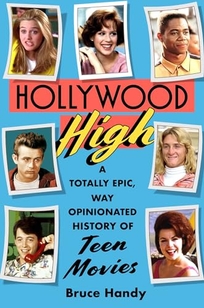
Bruce Handy. Avid Reader, $30 (384p) ISBN 978-1-5011-8117-7
This piercing analysis from journalist and humorist Handy (
Wild Things) surveys how teen films throughout the decades have reflected adolescents’ shifting concerns and place in society. He suggests that teens “were seen less as their own species than as not-quite adults” well into the 1930s and ’40s, as exemplified by Mickey Rooney’s Andy Hardy films, which followed the quaint tribulations of the teen protagonist but were aimed as much at parents as kids. The notion of the teenager as a distinct archetype with their own culture emerged alongside booming high school attendance rates spurred by New Deal–era compulsory education laws. This shift inspired such postwar movies as
Rebel Without a Cause, which dramatized anxieties around the growing gulf between parents and their emboldened children. Handy also traces shifting attitudes around adolescent sexuality, discussing how the Beach Party movies of the 1960s showed “lots of flesh but no sex” and how
Fast Times at Ridgemont High reflected growing levels of sex positivity across the 1970s. Elsewhere, Handy examines how
Mean Girls arose out of a moral panic around female bullying and how the Hunger Games franchise dramatized teen defiance. The smart exegesis provides both a doting love letter to teen films and a fascinating history of the teen’s place in society. This entertains.
Agent: Jennifer Joel, CAA. (May) 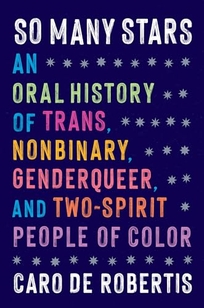
Caro De Robertis. Algonquin, $32 (320p) ISBN 978-1-64375-687-5
In this scintillating oral history, novelist De Robertis (
The Palace of Eros) weaves together the voices of 20 trans and gender nonconforming people of color in their 50s, 60s, and 70s in order to explore what it was like for their generation to come of age, as well as to record and memorialize the struggle for the right to free gender expression that these individuals pioneered. The book is structured by life stage, beginning with childhood exploration of identity and family responses; followed by building communities in adulthood, when many of the subjects leaned into activism; and finally, aging as a queer person and mentoring the next generation. De Robertis creates an evocative palette of experience that sheds unique light on the role trans people of color have played in everything from the evolution of the drag scene to activism during the AIDS crisis, but also surfaces more ephemeral cultural moments of the ’70s, ’80s, and ’90s—for example, using the excuse of “being a goth” to wear makeup; navigating the rigid divide between Black and white lesbian communities, which were sometimes housed in the same clubs; and moving to California because, as one Latino trans woman recalls, the increasing number of white migrants to her hometown of Tucson were less accepting of her gender expression. It’s an utterly riveting view of LGBTQ+ life in America.
(May) 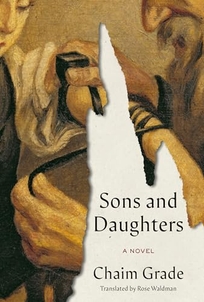
Chaim Grade, trans. from the Yiddish by Rose Waldman. Knopf, $35 (704p) ISBN 978-0-394-53646-0
This magisterial family saga by Grade (
Rabbis and Wives), which was originally serialized in the 1960s and ’70s in New York City’s Yiddish newspapers, chronicles the erosion of a small Polish village shortly before the outbreak of WWII. Village rabbi Sholem Katzenellenbogen has five children, each of whom is pursuing a different path. His oldest son, Naftali, has left the village to study philosophy in Switzerland. The middle son, Bentzion, puts himself through night school, hoping to become a businessman. Sholem’s daughter Tilza is married to a rabbi, while her younger sister, Bluma Rivtcha, struggles in a bad marriage and longs to become a nurse. She defends Bentzion’s career choice to a disdainful Sholem by claiming her brother simply wants to be an “independent person.” The youngest son, Refael’ke, becomes radicalized by Zionist agitators, a cause his grandfather rebukes (“What right do irreligious Jews have to demand a piece of the land flowing with milk and honey?”). Grade, who died in 1982, never alludes to the Holocaust, but its weight informs his elegiac portrait of a bygone life, in which each chapter feels like a fully realized story and the many characters are depicted in compassionate detail. It’s an enormous achievement.
(Mar.) 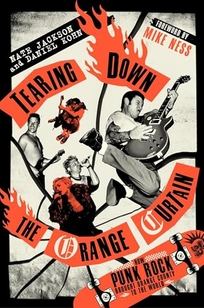
Nate Jackson and Daniel Kohn. Da Capo, $30 (400p) ISBN 978-0-30683-296-3
Music journalists Jackson and Kohn debut with a vivid genealogy of Orange County, Calif., punk music. Tracing the genre’s origins to Costa Mesa’s Cuckoo’s Nest club in the 1970s, where bands sought to “blow away the weak, square and boring rock and pop of the ’70s” with a sound and style that broke all the rules, the authors capture its evolution from “escape from... middle-class life” for bored suburban youth through violent subculture to an established part of mainstream music. Along the way, the authors follow such bands as Sublime, T.S.O.L., and the Adolescents as they traded members, drew diehard fans, toured, and frequently dissolved thanks to drug abuse or infighting. Jackson and Kohn also document adjacent scenes (such as 1970s skate culture, which—like punk music—“relied on aggression, tension release, blood, sweat and devotion” and turned kids into cop targets) and highlight the tensions that arose when bands that hit it big were accused of selling out. Fluidly drawing from historical records and personal interviews, the authors employ colorful detail to bring alive the punk world in all its fist-swinging, house-destroying glory—while hinting at pitfalls that contributed to its eventual demise (including, ironically, acceptance by mainstream musical culture that threw the genre into something of an identity crisis). The result is a spirited portrait of an influential subculture.
(May) 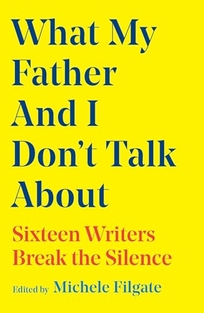
Edited by Michele Filgate. Simon & Schuster, $29.99 (320p) ISBN 978-1-6680-4965-5
Novelists, poets, and essayists reflect on their relationships with their fathers in this intense companion piece to Filgate’s 2019 anthology,
What My Mother and I Don’t Talk About. There are a few lighthearted selections, such as Kelly McMasters’s soulful account of bonding with her reserved father over his passion for gardening. However, most entries are more unflinching than feel-good. For instance, in the searing “You Knew About That,” Heather Sellers mournfully recalls how her alcoholic, absentee father’s chronic reticence hampered her attempts to reconnect with him toward the end of his life. Elsewhere, Nayomi Munaweera discusses how taboo around divorce kept her Sri Lankan parents from ending their arranged marriage until their 80s despite constant bickering and her father’s occasional bouts of violence; Jaquira Díaz describes convincing her father to open up about a rumored son from a relationship he’d had during a brief stint in New York City before moving back to Puerto Rico in the 1970s; and Robin Reif recounts the emotional devastation wrought by her father’s preference for his son, which left her competing with her brother for her father’s affection while her brother withered under the pressure to live up to his father’s expectations. Though the devastating entries occasionally threaten to emotionally exhaust readers, there’s no denying their poignancy and power. Readers will want to keep tissues handy.
Agent: Mel Flashman, Janklow & Nesbit Assoc. (May)








